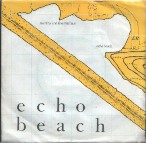Some acts must get really frustrated when their first hit is so massive, having received stacks of continuous airplay and hung around the chart for so long that it finds its way into the human psyche almost by osmosis, then they can’t follow it up and they remain a one hit wonder. Such was its impact that even 10, 20, 30 or more years on it still sounds as fresh as the day it charted. One such song is 1980s Echo Beach by Martha & The Muffins.
Martha was lead singer Martha Johnson and her Muffins were; guitarist and songwriter Mark Gane, saxophonist Andy Haas, bassist Carl Finkle, keyboard player Martha Ladly and drummer Tim Gane. They were formed in 1977 in Toronto and, according to Gane, “We temporarily chose the name Martha and the Muffins to distance ourselves from the aggressive names adopted by many punk bands that were around at the time but we couldn’t all agree on something better so the name ended up sticking for the next seven years.”
In 1979 they travelled to the UK to record their debut album Metro Music which also featured their hit single Echo Beach. It was produced by Mike Howlett and recorded at Oxford’s Manor Studios.
Echo Beach was only the third song Gane had written and it came about while he was a student at the Ontario College of Art. “I had a job one summer at a paint and wallpaper factory. It was so boring that I daydreamed a lot. Echo Beach didn’t really exist as a location, it was a symbol of a place everyone wants to escape to when they’re not where they want to be. The inspiration was Sunnyside Beach on the shoreline of Lake Ontario in Toronto.” remembered Gane, “The lake and beach could have been in the middle of nowhere while the city behind became a surrealistic sight.”
If you have the single in a picture sleeve then have a close look to see which one you have because there were two maps. The map on the original issue was of the Toronto Islands, whilst later issues show Chesil Beach in Dorset.
When Mark wrote Echo Beach, did he think it would become a classic? “The song had legs but we could have never anticipated that,” he said. “If somebody had said then that song is going to be as popular 25 years on, I wouldn’t have believed it. But I can see in retrospect how it has appealed to people. My father always said one reason he thought it was a hit is because it’s nostalgic, and any song that has nostalgia in it hits a chord with people and I think to some extent he’s right. We’re also the only Canadian act to make Mojo magazine’s list of 100 Singles You Must Own.”
There have been a select few who had covered this song and the only one to chart in the UK was Toyah’s version in 1987 where it reached number 54. In 2008 there was a TV drama series called Echo Beach which featured Martine McCutcheon and Jason Donovan and the programme’s theme was sung by Gabrielle Cilmi. The track also featured on her album Lessons to Be Learned.
Why was their not a follow up single? Martha explained, “The follow up was chosen by the head of the record company, which was DinDisc at that time. And the band really didn’t agree with their choice but they went ahead anyway with a song called Saigon. I think (the single) probably should have been Paint by Number Heart or Indecision. After the success in England, Canada followed suit and throughout Europe and in Australia, everywhere it was released the song went top ten as well.”
With no follow up success, the band decided, in 1984, to release a track called Black Stations/White Stations under the moniker M + M and, although a catchy tune, only reached number 46 in the UK.
Gane and Johnson later married and had a daughter in 1992 called Eve so their commitments turned to their child. In 1995 Martha released a solo album of children’s music called Songs from the Tree House and just credited to Martha. Just about a year ago, Martha released her latest album with Gane producing and it included a collaboration with Ron Sexsmith.
What happened to the rest of the Muffins I hear you ask?, Well, Carl Finkle, after a short spell in production, became an architect and swimming pool designer, Tim Gane became a mechanic with the Canadian Automobile Association and Andy Haas became a security guard in an art museum.
